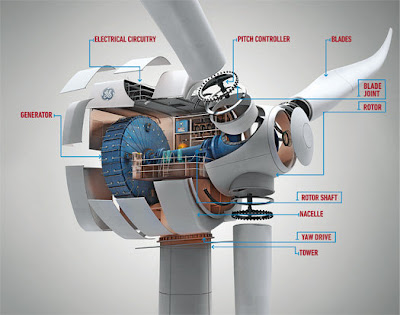GE has broken new ground in their newest turbine design. This gearless generator has so much potential. It is almost certain to revolutionize turbine repair and maintainance. This turbine is also a 4mw generator making it a hard hitter in the realm of energy generation. The electricity produced with one, the less footprint made on ocean floors. The footprint issue is also a concern for land based installations where the number of acres covered by footings and foundations cuts in (however minimally) to agricultural use and vegetation habitit.
Some technicians could get sucked into the old-world way of thinking "less job security-less maintainance",
but considering the number of technicians that will be needed to meet the renewable energy mandates of the coming 20 years, I am not concerned. This design class will make renewable energy cost less, and therefore will make it even more preferable to non-renewables.
Credit for this image goes to POPSCI and GE. I lifted it from this nice article http://www.popsci.com/technology/article/2010-03/next-gen-wind-turbine
and hope that my using it will benefit GE and the wind industry.
Possibly the largest benefit to lower maintainance designs is that they become more usable in off-shore and hard to reach applications where they will be out of the way, and capitalize on harsher conditions where there is more wind to be harnessed.
These ocean and lake based installs (see Lake Erie)
offer much potential, but are very difficult and costly to service and maintain.
This recent innovation in low-maintainance turbines stands to push off-shore applications to the forefront. They effect wildlife less, and counter the weak but prevalent "eyesore" complaint from wind energy opponents.







